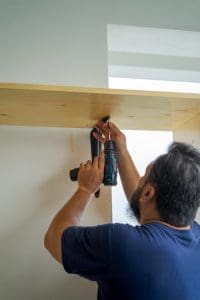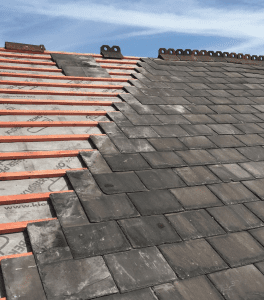Maintaining a watertight roof is an ongoing challenge for homeowners across the UK, especially with the country’s unpredictable and often harsh weather conditions. From persistent rain and high winds to cold, frosty winters, roofs in the UK endure significant stress. Identifying and addressing the common sources of roof leaks specific to the UK climate is essential for keeping homes secure and protected. In this article, we’ll explore some of the most prevalent causes of roof leaks across the country, highlighting how the UK’s unique weather patterns exacerbate these issues and offering advice on how to prevent costly damage.
Weathering and Ageing Roofs
One of the most common causes of roof leaks in the UK is simply the natural ageing of roofing materials over time. Constant exposure to rain, wind, frost, and even the occasional heatwave can cause roofing materials to deteriorate. Tiles may become brittle or cracked, lose their protective granules, or shift out of place. As roofing materials age, they become less effective at keeping out moisture, making them more vulnerable to leaks during heavy rainfall.
UK weather patterns, particularly in areas with frequent rain or harsh coastal winds, can accelerate the wear and tear on roofs. To prevent minor issues from turning into serious leaks, regular roof inspections are key, especially after extreme weather events like storms. Addressing any signs of ageing, such as cracks or missing tiles, will help extend the lifespan of your roof and protect your home from water damage.
Damaged or Missing Roof Tiles
High winds, common in many parts of the UK, can easily cause tiles to become dislodged or broken. When roof tiles are damaged or missing, the underlying felt or roofing material is exposed, leaving the roof vulnerable to water infiltration. This is particularly concerning in the UK, where heavy rain can quickly find its way through gaps left by missing or damaged tiles.
While it’s impossible to prevent the weather from affecting your roof, you can minimise the risk of leaks by regularly checking your roof for signs of tile damage. Wind-prone areas in particular should prioritise prompt replacement of any damaged or missing tiles to keep the roof watertight and prevent further issues from developing.
Faulty Flashing and Leadwork
Flashing and leadwork are crucial components in any roofing system, particularly around chimneys, skylights, vents, and other roof penetrations. Their job is to create a watertight seal around these vulnerable areas, preventing water from seeping into the roof. However, with constant exposure to the UK’s wet climate, flashing and leadwork can deteriorate, corrode, or shift over time, creating gaps where water can enter the property.
Regular inspections of flashing and leadwork are essential to ensure that these critical areas remain sealed and intact. If you notice any cracks, gaps, or signs of corrosion, it’s important to have them repaired as soon as possible to prevent leaks from damaging your roof and the interior of your home.
Clogged Gutters and Downpipes
Gutters and downpipes play a crucial role in directing rainwater away from your roof and home. However, in the UK, where frequent rainfall is the norm, gutters and downpipes can quickly become clogged with leaves, debris, or moss, obstructing the flow of water. When this happens, water can back up and pool on the roof, eventually seeping through weak points and causing leaks.
Ensuring that your gutters and downpipes are clear and free-flowing is a simple yet effective way to prevent roof leaks. Regular gutter cleaning, particularly in the autumn when leaves are more likely to accumulate, will help maintain proper water drainage and reduce the risk of water-related damage to your roof.
Poor Roof Installation
In some cases, roof leaks in the UK are caused by improper installation. Whether it’s inadequate sealing, poorly laid tiles, or subpar materials, a poorly installed roof is more likely to develop leaks over time. Unfortunately, these issues may not become apparent until the roof is put to the test by extreme weather conditions.
To avoid future leaks and costly repairs, it’s important to hire reputable and experienced roofing professionals for any installation or repair work. A properly installed roof should be able to withstand the diverse weather conditions the UK experiences, from heavy rains to strong winds, ensuring your home remains protected for years to come.
Moss and Algae Growth
The damp and often overcast climate in many parts of the UK provides ideal conditions for moss and algae to thrive on roofs. Moss, in particular, can hold onto moisture, which increases the likelihood of water penetrating your roof’s surface. Over time, moss and algae can also cause tiles to lift, crack, or deteriorate, further exposing your roof to leaks.
While moss may seem harmless, allowing it to grow unchecked can lead to significant roofing issues. Regular roof cleaning and moss removal are essential for maintaining the integrity of your roof and preventing leaks. However, it’s important to approach moss removal with caution—improper techniques can cause more harm than good. Consulting a professional for safe moss removal is often the best approach.
Flash Flooding and Heavy Rainfall
The UK is no stranger to heavy rain and flash flooding, both of which can put a roof under immense pressure. In areas prone to torrential rain, roofs must be equipped to handle significant amounts of water in a short period. When rainwater accumulates faster than it can drain away, it can seep through weak spots in the roof, such as damaged flashing, cracked tiles, or clogged gutters, leading to leaks and interior damage.
Flash flooding can be particularly damaging in low-lying or coastal areas, where rising water levels can also impact foundations and external walls. Ensuring that your roof is in good condition and that water can drain away efficiently will help minimise the risk of leaks during periods of heavy rain.
Insufficient Ventilation and Condensation
In colder months, the UK’s climate often leads to condensation building up in attic spaces or roof voids, particularly if there is inadequate ventilation. When warm, moist air rises from the living spaces below and meets the cold roof surface, it condenses, leading to moisture accumulation in the roof space. Over time, this can lead to mould growth, wood rot, and structural damage, ultimately contributing to leaks.
Ensuring that your roof has adequate ventilation is key to preventing condensation-related issues. Roof vents allow air to circulate freely, helping to regulate temperature and moisture levels in your attic or roof void. Proper insulation and ventilation are particularly important for older properties, which may be more prone to condensation problems.
Conclusion
Roof leaks are a common concern for homeowners across the UK, driven by a combination of weather conditions and the natural ageing of roofing materials. From the weight of heavy rain and strong winds to the persistent presence of moss and algae, the challenges faced by UK roofs are numerous. However, with regular maintenance, prompt repairs, and proper installation practices, these issues can be effectively managed, extending the lifespan of your roof and protecting your home from water damage.
Whether you’re dealing with damaged tiles, faulty flashing, or clogged gutters, proactive care and the assistance of experienced roofing professionals like 3D Construction can help ensure that your roof remains watertight and secure throughout the year. Investing in regular inspections and maintenance is key to preventing leaks and safeguarding your property from the unpredictable UK climate.




